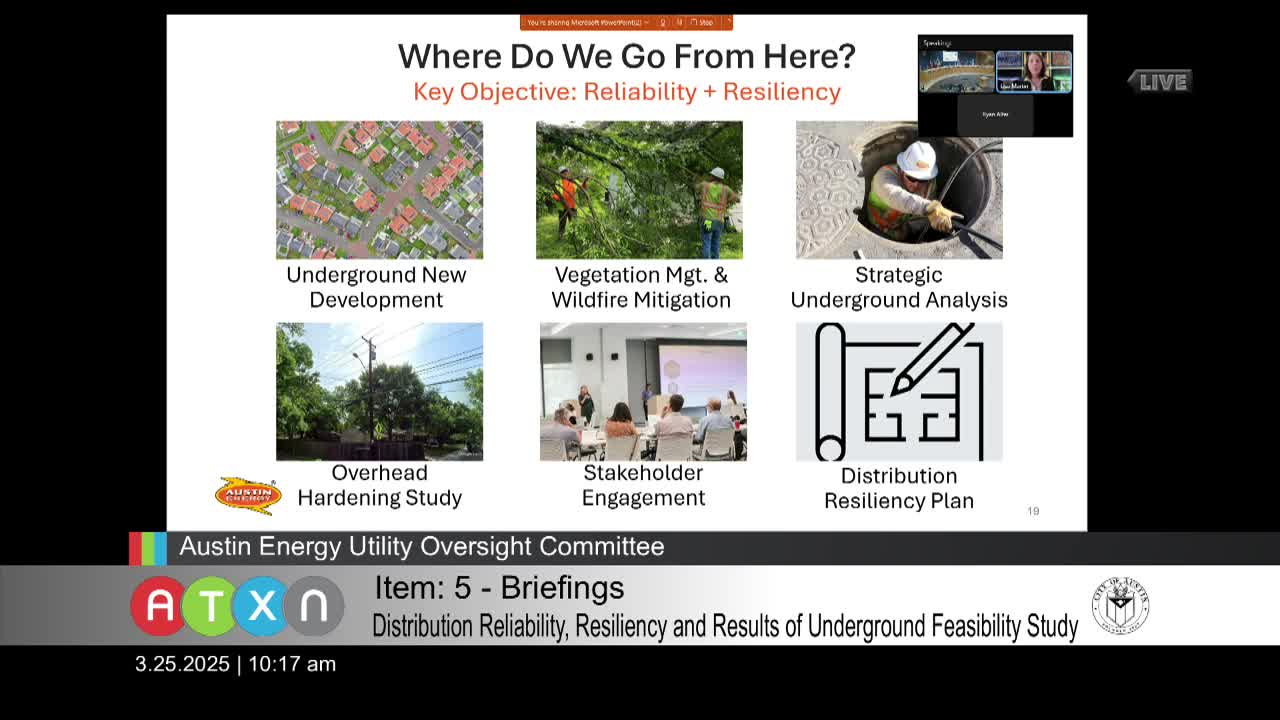Austin Council reviews wildfire risk and undergrounding feasibility studies for utility infrastructure
March 25, 2025 | Austin, Travis County, Texas
This article was created by AI summarizing key points discussed. AI makes mistakes, so for full details and context, please refer to the video of the full meeting. Please report any errors so we can fix them. Report an error »

The Austin Energy Utility Oversight Committee convened on March 25, 2025, to discuss critical issues surrounding the city's energy infrastructure, particularly focusing on wildfire risks and the management of overhead and underground power lines.
The meeting began with a presentation emphasizing the ongoing efforts to mitigate risks associated with wildfires and tree proximity to power lines. The committee highlighted the importance of tree trimming and wildfire mitigation programs, which are essential during various weather conditions, including wind, ice, and drought. The discussion included plans for strategic underground conversions and the upcoming overhead hardening study, which aims to enhance the resilience of the power distribution system.
Councilmember Fuentes raised concerns about the feasibility of undergrounding power lines in certain areas, particularly in the Northwest, due to geological challenges. The committee acknowledged these concerns and committed to engaging with stakeholders to gather feedback on the proposed strategies. They anticipate sharing the results of the overhead hardening study in May, which will inform both immediate and long-term priorities for the energy distribution plan.
Councilmember Duchin inquired about the feasibility analysis conducted regarding wildfire risks, emphasizing the need to consider topography and wind factors in future studies. The committee confirmed that while wildfire risk was not specifically included in the initial analysis, it remains a priority in their ongoing evaluations.
The conversation also touched on the costs associated with undergrounding existing power lines, with estimates suggesting that burying all lines would be prohibitively expensive. However, the committee noted that new developments often opt for underground lines due to lower initial costs and aesthetic benefits. Councilmember Alter suggested exploring policy changes to incentivize undergrounding in high-growth areas, particularly in the Northeast Planning District.
The committee acknowledged the complexities involved in coordinating with telecom companies when converting overhead lines to underground. They clarified that telecom providers are responsible for covering the costs associated with moving their lines during such conversions, although this process can be cumbersome.
In conclusion, the meeting underscored the committee's commitment to addressing wildfire risks and enhancing the reliability of Austin's energy infrastructure. The upcoming studies and stakeholder engagement will play a crucial role in shaping the city's distribution resiliency plan, with further discussions anticipated in the coming months.
The meeting began with a presentation emphasizing the ongoing efforts to mitigate risks associated with wildfires and tree proximity to power lines. The committee highlighted the importance of tree trimming and wildfire mitigation programs, which are essential during various weather conditions, including wind, ice, and drought. The discussion included plans for strategic underground conversions and the upcoming overhead hardening study, which aims to enhance the resilience of the power distribution system.
Councilmember Fuentes raised concerns about the feasibility of undergrounding power lines in certain areas, particularly in the Northwest, due to geological challenges. The committee acknowledged these concerns and committed to engaging with stakeholders to gather feedback on the proposed strategies. They anticipate sharing the results of the overhead hardening study in May, which will inform both immediate and long-term priorities for the energy distribution plan.
Councilmember Duchin inquired about the feasibility analysis conducted regarding wildfire risks, emphasizing the need to consider topography and wind factors in future studies. The committee confirmed that while wildfire risk was not specifically included in the initial analysis, it remains a priority in their ongoing evaluations.
The conversation also touched on the costs associated with undergrounding existing power lines, with estimates suggesting that burying all lines would be prohibitively expensive. However, the committee noted that new developments often opt for underground lines due to lower initial costs and aesthetic benefits. Councilmember Alter suggested exploring policy changes to incentivize undergrounding in high-growth areas, particularly in the Northeast Planning District.
The committee acknowledged the complexities involved in coordinating with telecom companies when converting overhead lines to underground. They clarified that telecom providers are responsible for covering the costs associated with moving their lines during such conversions, although this process can be cumbersome.
In conclusion, the meeting underscored the committee's commitment to addressing wildfire risks and enhancing the reliability of Austin's energy infrastructure. The upcoming studies and stakeholder engagement will play a crucial role in shaping the city's distribution resiliency plan, with further discussions anticipated in the coming months.
View full meeting
This article is based on a recent meeting—watch the full video and explore the complete transcript for deeper insights into the discussion.
View full meeting
